|
Dryoscopus cubla (Black-backed
puffback, Puffback)
Sneeubal [Afrikaans]; Intakembila, Unomaswana [Xhosa];
iBhoboni (also applied to Southern Boubou) [Zulu]; Nankuwo [Kwangali]; Phavomu
[Tsonga]; Poederdonsklauwier [Dutch]; Cubla boule-de-neige [French];
Schneeballwürger [German]; Picanço-de-almofadinha [Portuguese]
Life
> Eukaryotes >
Opisthokonta
> Metazoa (animals) >
Bilateria >
Deuterostomia > Chordata >
Craniata > Vertebrata (vertebrates) > Gnathostomata (jawed
vertebrates) > Teleostomi (teleost fish) > Osteichthyes (bony fish) > Class:
Sarcopterygii (lobe-finned
fish) > Stegocephalia (terrestrial
vertebrates) > Tetrapoda
(four-legged vertebrates) > Reptiliomorpha > Amniota >
Reptilia (reptiles) >
Romeriida > Diapsida > Archosauromorpha > Archosauria >
Dinosauria
(dinosaurs) > Saurischia > Theropoda (bipedal predatory dinosaurs) >
Coelurosauria > Maniraptora > Aves
(birds) >
Order: Passeriformes
> Family: Malaconotidae
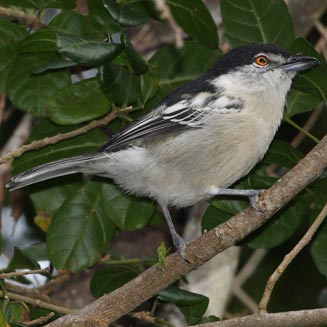 |
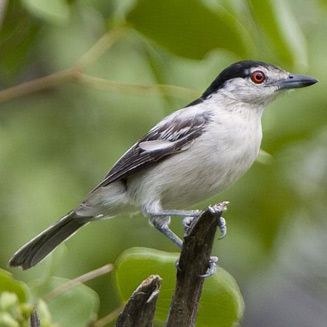 |
|
Black-backed puffback male in non-breeding plumage, Tsitsikamma National Park,
Eastern Cape. [photo
Duncan Robertson ©]. |
Black-backed puffback female, Kruger National
Park, South Africa. [photo Trevor Hardaker ©] |
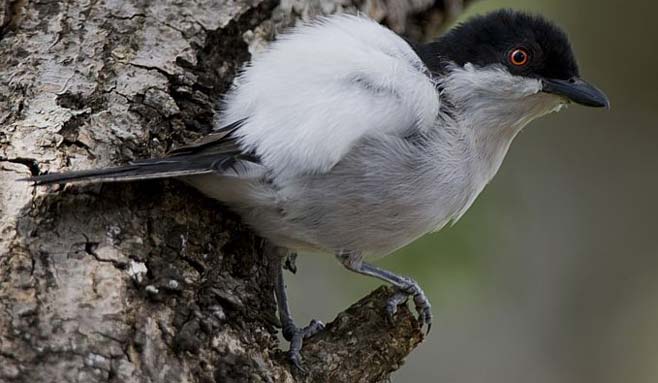 |
|
Black-backed puffback, Thornybush Game Reserve,
South Africa. [photo Trevor Hardaker ©] |
Distribution and habitats
Occurs from Angola and East Africa to southern Africa,
where it is locally common across Mozambique, Botswana, eastern Zimbabwe,
Limpopo Province and coastal habitats from KwaZulu-Natal to Swellendam, Western
Cape. It generally prefers woodland habitats, as well as evergreen forest edges,
riverine forest, Eucalyptus plantations and suburban gardens.
|
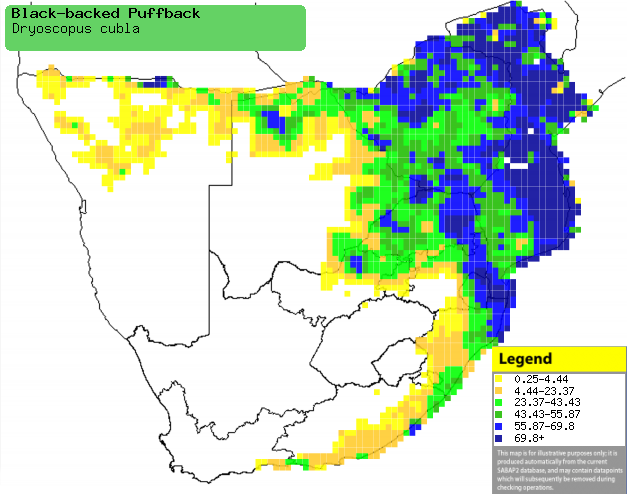 |
|
Distribution of Black-backed puffback in southern Africa,
based on statistical smoothing of the records from first SA Bird Atlas
Project (©
Animal Demography unit, University of
Cape Town; smoothing by Birgit Erni and Francesca Little). Colours range
from dark blue (most common) through to yellow (least common).
See here for the latest distribution
from the SABAP2. |
Predators
It has been recorded as prey of the following animals:
Food
It mainly eats insects, doing most of its foraging in the
upper canopy, gleaning insects from leaves and branches and occasionally
catching prey in flight. The following food items have been recorded in its
diet:
- Invertebrates
- Plants
- fruit of Salvadora (mustard tree)
- Acacia buds
Breeding
- The nest is a tidy, compact cup made of grass, roots and bark bound
together with spider web and lined with fine grass. It is built solely by
the female, while the male helps collect material, regurlarly displaying and
calling nearby. It is often decorated with lichen and bark, so that it is
camouflaged with the forked branch it is bound to.
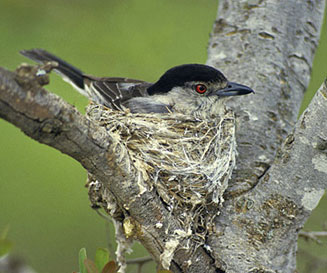 |
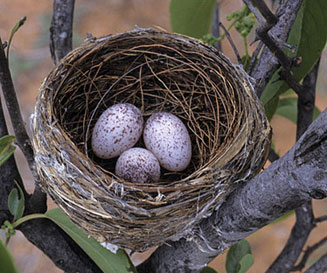 |
|
Black-backed puffback incubating its eggs, which
are pictured to the right, Sericea farm, South Africa. [photo Warwick Tarboton ©] |
- Egg-laying season is almost year-round, but it usually peaks around
September-December.
- It lays 2-3 eggs, which are incubated mainly by the female for about 13
days. The male regurlarly gives her food, occasionaly taking over for short
periods so that she can forage for herself.
- The female is given food by the male, especially insects, which she then
feeds to the young nestlings. The chicks stay in the nest for about 18 days
and can fend for themselves 3 weeks later, but they can still remain in
their parents territory into the next breeding season.
Threats
Not threatened.
References
-
Hockey PAR, Dean WRJ and Ryan PG 2005. Roberts
- Birds of southern Africa, VIIth ed. The Trustees of the John Voelcker
Bird Book Fund, Cape Town.
|
